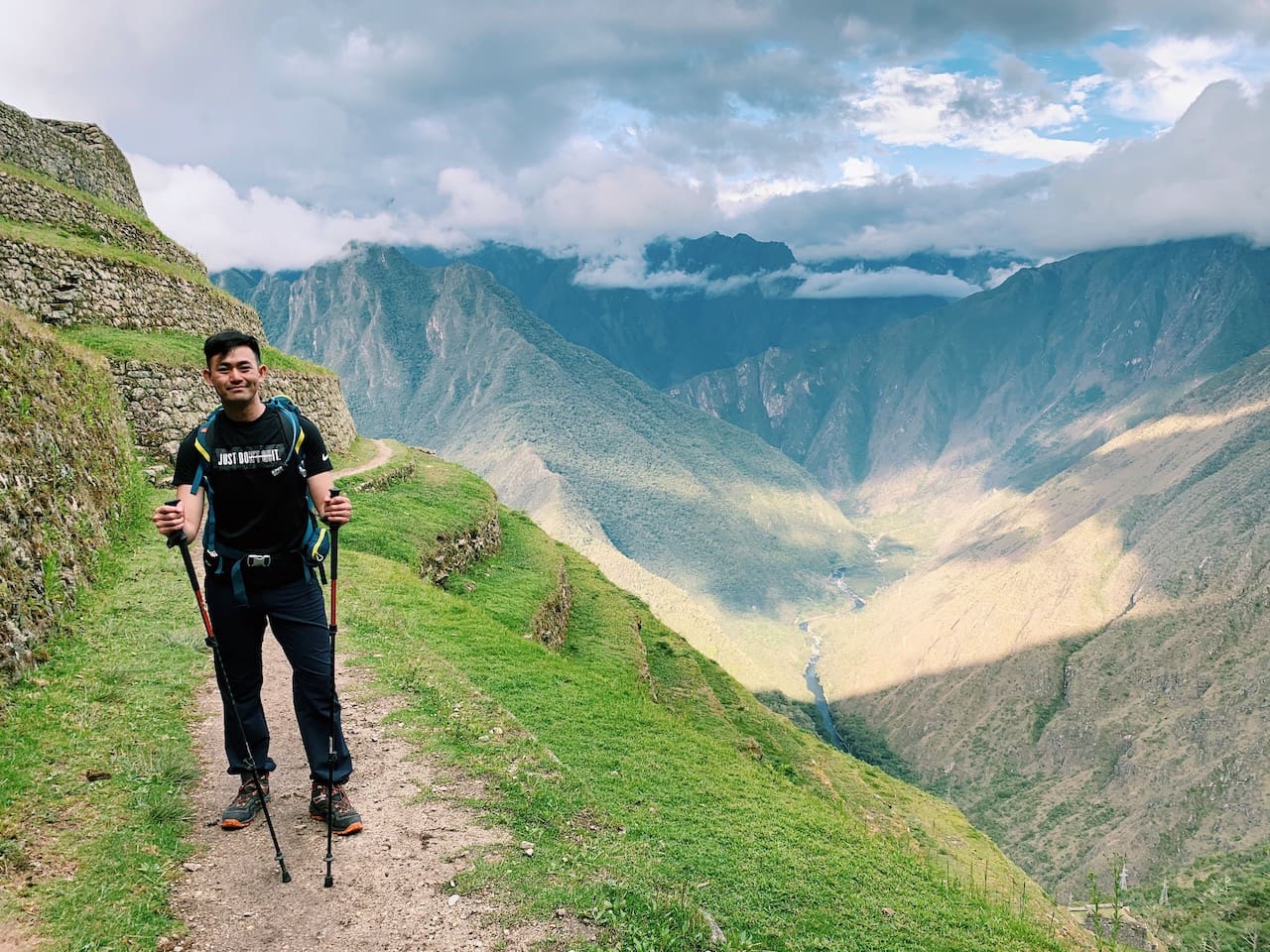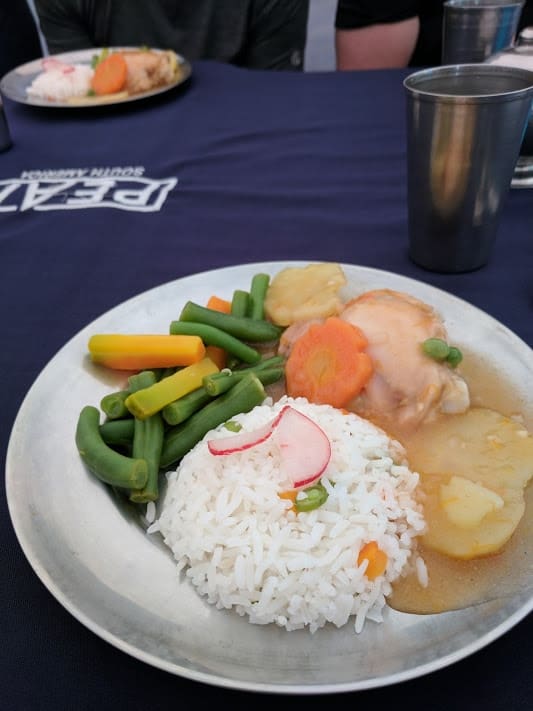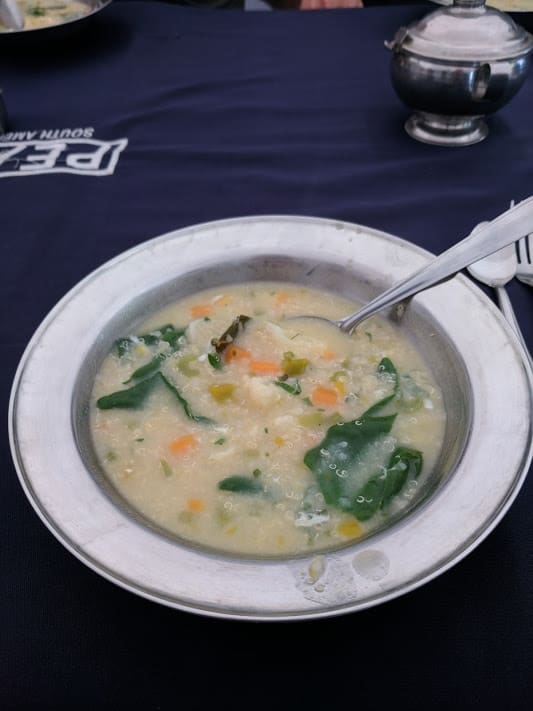Peru: The Inca Trail and Machu Picchu is our most popular Active all-gay adventure. If you’re considering joining one of the tour’s two annual departures—or you’re already signed up and want to prepare for the journey—here’s everything you need to know.
Introduction to the Inca Trail and Machu Picchu

What is the Inca Trail?
The Inca Trail is a historic hiking trail through Peru’s Andean Mountain Range. Beginning in the Sacred Valley and concluding on a cliff above Machu Picchu known as the Sun Gate, the trail swerves through cloud forest, subtropical jungle, Incan ruins and gorgeous mountain passes. It is the most famous trail in South America, attracting thousands of annual visitors looking to strike it off their respective bucket lists.
What is Machu Picchu?
Machu Picchu is one of the new seven wonders of the world, and one of the world’s most famous archeological sites. It is an Incan citadel built high in the Andes and is backdropped by lush, green tundra. The UNESCO-listed site is believed to have been constructed around 1450 as an estate for the Incan emperor Pachacuti, though some debate on its original purpose still exists. Although always known among native Peruvians, the site was abandoned shortly after Spanish colonization and was only brought to international prominence again when historian Hiram Bingham “discovered” it in 1911.
What will I see/experience on the Inca Trail?
Machu Picchu is the prize awaiting everyone who completes the Inca Trail. On our tour you’ll arrive at the Sun Gate above Machu Picchu just in time for sunrise. If the fog isn’t too thick you will be granted an unforgettable look at the ancient wonder. After wallowing in the view, you’ll enjoy a 2-hour guided tour of the site learning about its many mysteries. Please note: As of July 2018, no one can enter Machu Picchu without a professional guide.
Aside from Machu Picchu, you will witness many extraordinary natural and ancient wonders along the trail. The hike will ascend and descend its way through lush cloud forest, subtropical jungle and alpine tundra. You will also glimpse spectacular glaciers and a few snow capped mountains (depending on the time of year). Birders will be delighted by the 400+ species native to the region. You’ll have the opportunity to photograph rare orchids, plenty of llama, and if you’re really lucky the spectacled bear. Regarding man-made sites, you’ll be pleasantly surprised by the ruins peppering the entire trail including Llactapata, Runkurakay and Sayacmarca.
Other than the hike, what else is on Out Adventures’ itinerary?
Our Peru: The Inca Trail & Machu Picchu adventure has changed over the years. In its current incarnation, you’ll begin in Lima with a dip into the capital’s famous food scene. If the group is up for it, we may even dive into the city’s lively gay district.
After Lima our tour flies to historic Cusco. This small city is often referred to as The Gateway to Machu Picchu. We’ll enjoy a guided city tour including a visit to San Pedro Market. Outside of Cusco we’ll witness local Andean culture in the Sacred Valley and Urubamba, including a visit to a local weaving women’s community where you can purchase authentic alpaca wares.
Finally, after our hike ends we’ll enjoy a unique train ride through the mountains. On the final day you have the option of visiting ruins at Saqsayhuaman, Qenqo and Tambomachay via private transport.
Difficulty of our gay Inca Trail hike

How difficult is the Inca Trail?
The difficulty of hiking The Inca Trail is very subjective. In our opinion, while it is challenging (especially Day 2 which brings you to a height of 13,779ft/4,200m), anyone who is in reasonable shape and does regular cardiovascular activity should be able to complete the trek. On our tour we take the trail at a comfortable pace with plenty of stops for water, rest and snacks. On average we’ll hike between 8–12km/5–7.5mi per day. However, the trail does tend to ascend/descend rapidly and because of the elevation, hikers can experience altitude sickness.
Is there only one route?
Yes. While there are many Incan trails there is only one “Inca Trail”. The trail is protected by the government of Peru and only 500 people are allowed on the trail at any time (200 visitors and 300 porters). Inca Trail Permits sell out months in advance.
Do people experience altitude sickness on the Inca Trail?
Altitude sickness and oxygen deprivation may be felt while travelling in high altitudes. Symptoms include shortness of breath, headaches, general lethargy, and a reduced appetite. It’s important that you drink plenty of water, and not overexert yourself. A comprehensive first-aid kit is carried by our support crew during treks, and senior staff are trained to prevent, detect and—if necessary—deal with AMS (Acute Mountain Sickness). Contrary to what many say, AMS is not that common, at least not on well-paced treks.
How far do we hike each day and what is the terrain like?
From start to finish, the trail is approximately 43km/26mi and we will hike approximately 8–12km/5–7.5mi per day. The path is clear and well marked however there are many steep inclines and declines. The terrain is somewhat uneven with roots and stones jutting out. The trail’s highest point is Dead Woman’s Pass at 13,779ft/4,200m above sea level.
What support will I have on the trail from Out Adventures?
On our tours you will feel extremely well supported. You will be joined by a local guide (likely Ale or Daniel) as well as a professional hiking guide and a team of porters. While your local guide will join you throughout the entire tour, our professional hiking guides and porters will join you at the beginning of the trail. They will assess everyone’s equipment before kicking off and recommend rentals if/when they are required. During the hike they are in charge of leading the group along the trail, ensuring a safe and fun trek.
Our team of porters will help carry your larger luggage, camping equipment and food. You will only have to carry a smaller daypack with snacks, water, camera and other daily essentials. Our porters will also hike ahead and set up camp and make dinner before we arrive.
If I have a recent injury, surgery, special physical requirement, can I still participate? What safety precautions are in place?
While we are more than happy to accommodate those with special physical requirements, the altitude can be a powerful variable. We recommend anyone with special physical requirements (especially a recent surgery) contact us in advance to discuss the details of the hike and your needs. If you do decide to join the group, before your tour we will collect more information about your special requirements and speak with our local guides to best prepare. If you require extra stops, one of our guides will be more than happy to walk slower with you.
It should be noted, if a recent injury or surgery prevents you from managing steep inclines, this may not be the tour for you. We recommend looking into some of our other all-gay hikes here, such as our Spain: Gay Madrid & The Camino de Santiago.
Also, if you’ll be over 70-years-old when the trip departs, we’ll have you complete a self-assessment form which will help us determine if we require any further information prior to booking.
I’m worried I might be the slowest/fastest walker. Can the team split up so I don’t hold other walkers up?
One of our main priorities is to ensure you have an enjoyable experience on the trail. And we understand that some people prefer to hike quickly, while others prefer to take things at a relaxed pace. If the group is moving at two different paces our local guides may split up, one leading the faster group and another leading the relaxed group.
Packing for the Inca Trail and other practical information
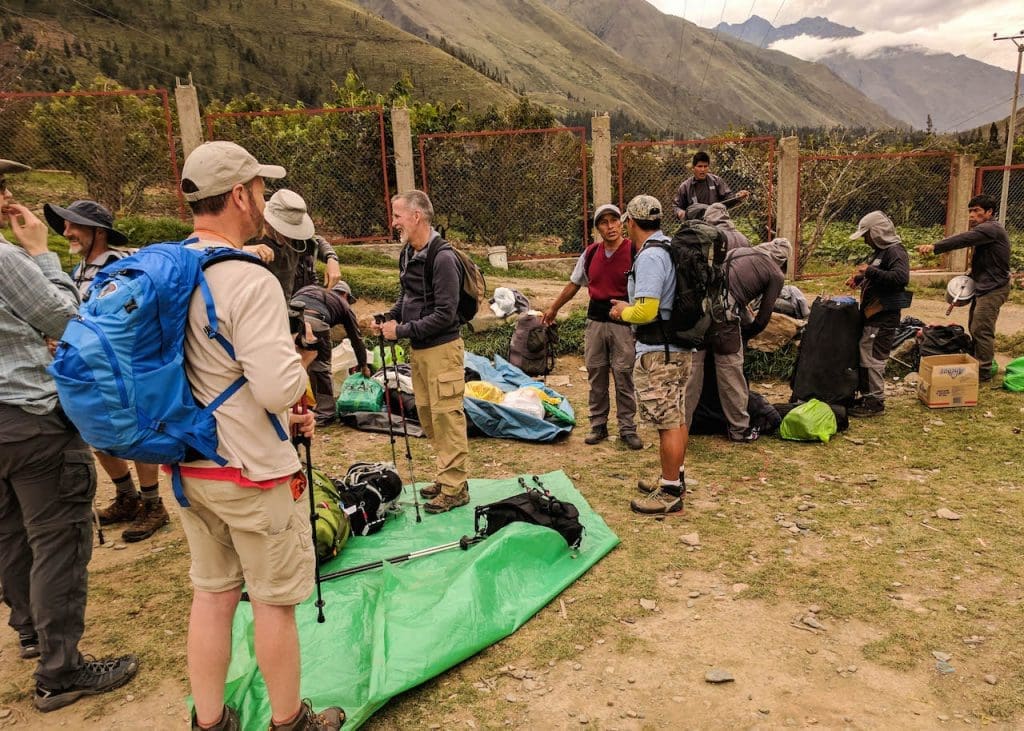
Do I need a trail permit to hike the Inca Trail?
Yes. However, on our tours we will handle the logistics of purchasing all permits well in advance.
Please keep in mind, local authorities release Inca Trail permits roughly 6–10 months in advance, and they often sell out within a few weeks. There are a limited number of permits sold, and when they are gone we must close our tour to new bookings. So we always recommend booking this adventure well in advance to guarantee your spot.
When is the best time to do the hike? When is Out Adventures’ hike?
Spring and fall are our favourite seasons to hike the Inca Trail and when our two organized hikes take place. In the Andes, the weather is very reasonable at this time with daily highs around 20C/68F, and evening lows around 4C/40F. While you’ll likely experience some rain and cloud cover on your trek, it will be nothing compared to the wet season (November through March). Please keep in mind the weather can be unpredictable and sometimes you need to make the most of less-than-desirable conditions.
What will the weather be like and how should I prepare accordingly?
Our hikes take place in May/June and September/October. You will experience daily highs around 20C/68F, and evening lows around 4C/40F. You will also likely experience some rain and cloud cover, and occasionally frost at night, so it’s important that you follow our recommended packing list.
Should I pack bug spray?
The short answer is yes, please pack bug spray for lower altitude sections of the hike as well as excursions in Cusco and the Sacred Valley. That said, the majority of our hike is in high altitude where there are little or no mosquitos. In stretches through lower elevations you may notice midges.
Will I have to carry all of my own luggage?
Our team of porters will carry your larger luggage from campsite to campsite, including all food and camping gear. Peruvian law strictly enforces the weight our porters may carry. You’ll be provided with a duffel bag for the trek which the porters will transport between campsites. You must keep your bag under 6kg/13.5lbs. You will be responsible to carry your own daypack which should include snacks, water, sunscreen, extra layers you may need throughout the day, camera, and other odds and ends you may want.
Anything specific I should pack?
Packing for the Inca Trail can be tricky as you must stay under 20kg/44lbs in your larger luggage bag which will be stored at our hotel in Cusco, but then as stated above your Inca Trail duffel bag must be under 6kg/13.5lbs, while still being prepared for a wide range of weather conditions. To assist you, we put together a thorough packing list here with plenty of recommendations. Feel free to email us with any specific packing related questions—we know you’ll have a couple!
What kind of hiking shoes/boots are appropriate for the Inca Trail?
Ultimately, hiking shoes/boots are a personal choice. However, our general recommendation is to go with a sturdy pair of waterproof hiking boots to provide your ankles a little extra support on ascents and descents—sneakers/running shoes are NOT appropriate footwear on the Inca Trail. The most important thing to remember is to make sure you’ve worn in your hiking boots before arriving. Otherwise, you run the risk of painful blisters that could dampen your trek.
For more information on footwear, please see our Ultimate Guide To Buying Hiking Boots.
Accommodations and “glamping” on our Inca Trail hike

What is “glamping”?
On our hike you’ll spend 4 nights “glamping”. In other words, glamourous camping. Our helpful team of porters will set-up and take-down our campsite every day. They will make us breakfast and dinner daily. There will be a ‘dining room’ at our site as well as a private, seated ‘bathroom’. Please see photos for a better understanding of what our campsites will look like.
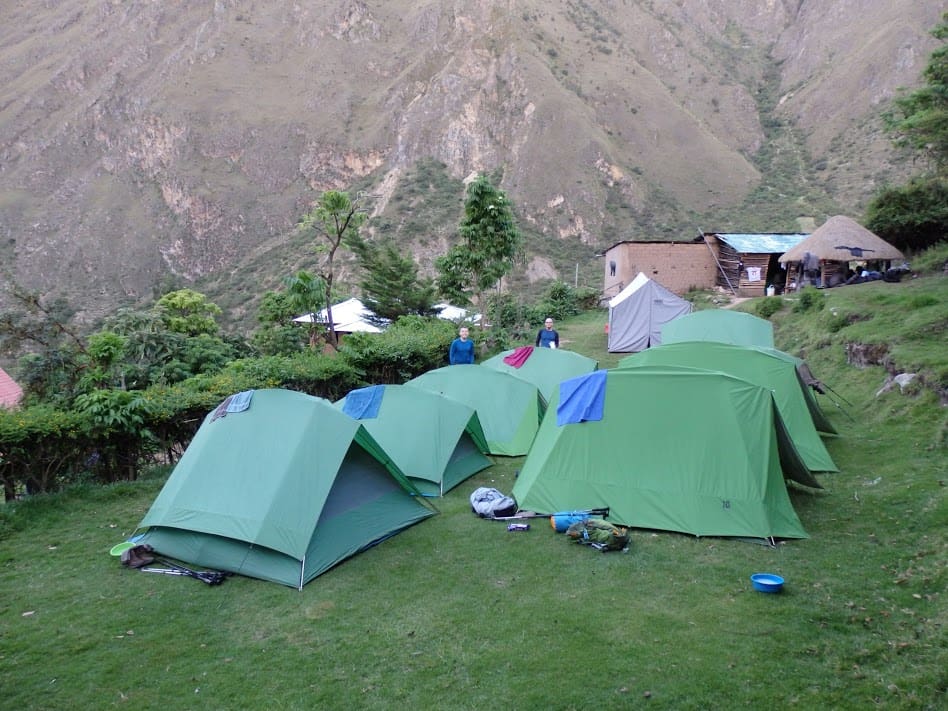
Glampsite 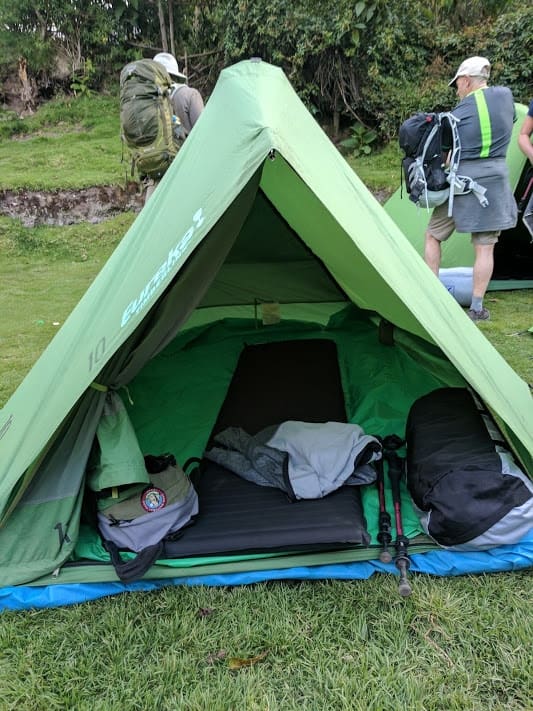
Single Supplement Tent 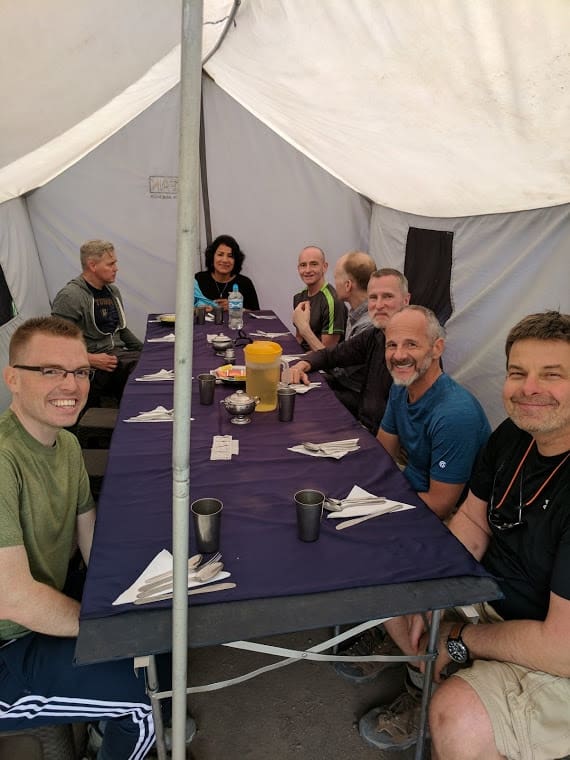
The Dining Hall 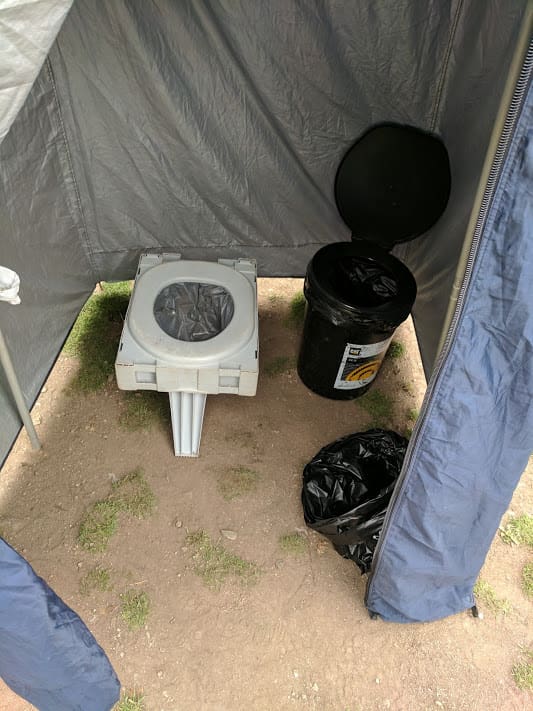
Private Bathroom 
Glampsite
Should I bring anything extra for the camping portion such as a sleeping mat, pillows, sleeping bags etc.?
We’ll take care of the larger essentials including tents, cookware, portable toilet etc. However, you will need to organize the following smaller items: sleeping bag, sleeping bag liner and pillow. If you prefer, these items can be purchased and/or rented when you arrive in Cusco. Please speak to your local guide when you arrive if you’d like to purchase these items upon arrival.
Can I rent equipment?
Yes, sleeping bags and hiking poles can be rented in Cusco before the adventure begins. Meanwhile, sleeping bag liners and pillows can be purchased in Cusco—they are not available for rental.
Can I purchase a single supplement if I don’t have a travel buddy? How much does it cost?
If you’re flying solo you have two accommodation options: bunk with another one of our guests that we’ll pair you with or purchase a single supplement and sleep in your own room/tent throughout. The cost of our single supplements vary from departure to departure. Visit the ‘Dates and Prices’ section on our Peru: The Inca Trail & Machu Picchu page for details.
Aside from camping during the hike, what other accommodations are used on Out Adventures’ tour?
In Lima, Cusco and Urubamba we use very comfortable 4+-star hotels. All of the accommodations include breakfast. They are stylish, spacious and come with some nice amenities. Customer service is extremely good at all three hotels.
Money in Peru

What is the currency in Peru?
The local currency is the Peruvian Nuevo Sol (PEN). We recommend carrying 1,500 PEN for small purchases and meals on our tour.
Will my credit/debit card work in most places in Peru?
Yes. Most large restaurants, large stores and hotels will accept international credit/debit cards. However, many smaller vendors and food stalls are cash only.
Are there many ATMs in the region?
In Lima and Cusco banks and ATMS are easily accessible. There are also plenty of exchange centres in tourist neighborhoods such as Miraflores in Lima. However, you will be hard pressed to find an ATM in the Sacred Valley and on the Inca Trail itself.
Dietary needs on our gay Inca Trail hike
What will I eat?
On the hike itself you will enjoy three full meals per day. Breakfasts will be served at camp and often include toast, fruit, oatmeal, coffee and tea.
Lunch is a fairly robust affair, ensuring you keep up your energy. For example you’ll be served veggies, potatoes, quinoa soup, pasta, rice or meat balls.
Finally, our past travellers have continually been impressed by our campsite dinners prepared by our amazing porter team. Expect rounded meals with either rice or potato, mixed vegetables and a protein such as chicken with a simple sauce or gravy. You may also be served a hearty soup or stew. On occasion, our team has even baked a cake for hikers celebrating their birthday on the trail!
How often will I eat?
On our hike we have scheduled three full meals per day with multiple opportunities to enjoy a quick snack en route. We encourage you to stop often for water and snack breaks.
Are snacks provided or should I bring my own?
Some basic snacks such as dried fruit, nuts and granola bars will be handed out before we kick off each morning. However, if you prefer something else to snack on such as chocolate, we encourage you to bring it.
What if I have a dietary preference or allergy? Is Peru/Out Adventures accommodating to food allergies?
Peru has come a long way in terms of dietary needs. Traditionally, Andean dinners consist of potatoes, starch and meat. However, on our tours we are very accommodating of most dietary requirements such as vegetarian, vegan and common allergies such as lactose intolerance.
Please speak to us well in advance if you have any strict dietary requirements that we need to prepare for.
LGBT Acceptance in Peru
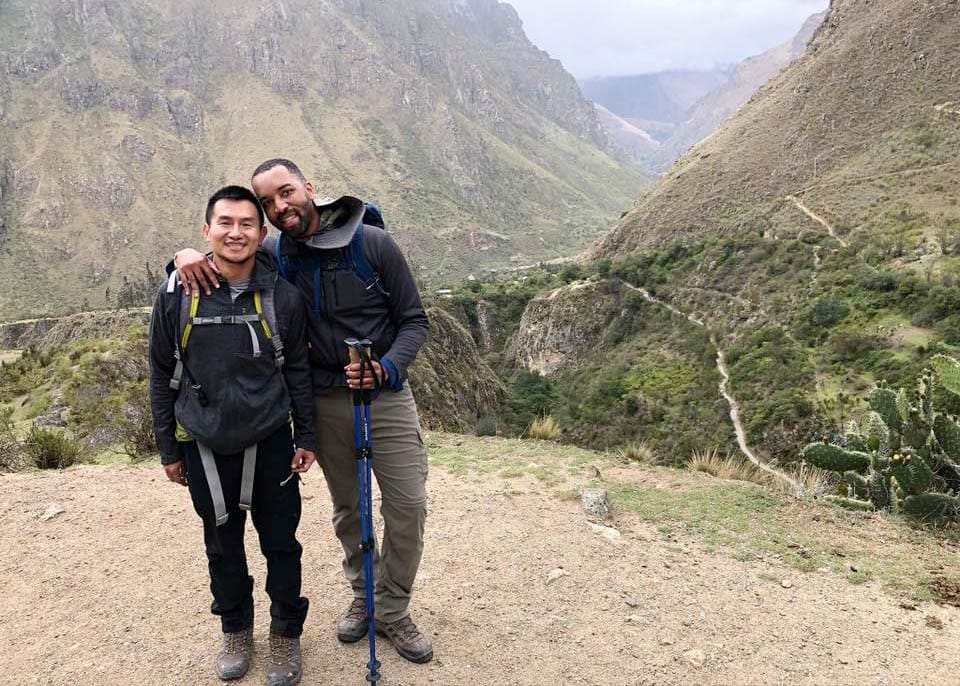
Is rural Peru gay-welcoming?
Peru is a predominantly catholic and conservative country with few legal protections for the LGBTQ+ community. However, Lima has a robust queer community and you won’t feel out of place in the city. Meanwhile, most of the rural destinations on our itinerary are popular among international travellers who likely won’t make a fuss over a group of men travelling together. That said, holding hands and public displays of affection may garner unwanted attention or uncomfortable stares.
Will we connect with Peru’s LGBTQ+ scene?
Yes! We always strive to connect our travellers with the local LGBTQ+ community.
On Day 1 of our Inca Trail tour, a local gay activist from Presente will join us for dinner. Over sips and nibbles they’ll share the positive work the organization is doing and answer any questions you may have about Peru’s LGBTQ+ movement. We’ve been so impressed with Present’s initiatives that we’ve decided to donate $50 from every Inca Trail tour sold to the organization.
Also, depending on how the group feels, we’ll have the opportunity to visit a gay bar in Lima and a gay-welcoming restaurant/bar in Cusco. Perhaps this is the perfect time to whip out those Spanish phrases you’ve been practicing?
Happy trails!
If you have any questions leading up to your big Inca Trail adventure, never hesitate to get in touch. Almost everyone in our office has hiked the trail and one of us has even lived in Lima for two years. We would be delighted to regale you with our endless tips and tricks to get the most out of your time in Peru and on the trail!
Photo Credits
Header photo courtesy of Kern Lim Hern Khoon. All other photo credits from top down: Shutterstock, Jeb Stenhouse x 8, Peak Expeditions, Jeb Stenhouse x 3, Robert Jones.
Featured Posts
Out Adventures' ultimate gay guide to purchasing hiking boots. Read More
Today's episode of The Gay Travel Podcast is a big Incan deal as we count down our top 10 experiences you can only have in Peru. Read More
A Q&A with an HIV+ traveller who refused to be held back by the virus and completed the Inca Trail in Peru with Out Adventures. Read More
An award-winning ecolodge, five-star dining and an array of exclusive excursions await the gay traveller interested in visiting the Peruvian Amazon with Out Adventures. Read More
Meet Daniel, Out Adventures' new gay Peru guide. Read More
Sweat and schlep on one of Out Adventures' epic international Gay Hikes. From the Peruvian Andes to exhausting Everest Base Camp. Read More
Introducing the Peruvian tour guide who's been making gay men and women feel welcome in her country for decades. Read More
In the interest of preserving Machu Picchu, local Peruvian Authorities enacted new regulations that control the number of visitors to the site and how they explore the ruins. Read More
10 nuggets of wisdom to consider before booking Out Adventures' gay hike towards Machu Picchu, Peru. Read More
